[slideshare id=13731103&doc=ffl-deck-final-reflection-120723133539-phpapp01]
As part of my work plan as Visiting Scholar at the David and Lucile Packard Foundation, I have the pleasure of working with networks of grantees to design and facilitate peer learning exchanges on networked nonprofit practices and using social media effectively. One of the networks I’m supporting are the grantees in the Friending the Finish Line strategy. This peer learning exchange is designed to help state-based groups to be more effective in engaging their networks toward covering uninsured children. Just like message consistency, storytelling, and interviewing skills, proficiency with social media like Facebook and Twitter increases their capacity to make change happen for children in their state.
I’m working in partnership with Spitfire Strategies. The peer learning exchange offers one-on-one coaching for 16 state organizations that work on children’s health care insurance, monthly peer webinars, and a face-to-face workshop. This technical assistance design is a balance of expert support with peer learning and an intentional strategy for building the network’s capacity. As with all the capacity building projects that I’ve designed, it is based on a framework and theory of change.
Assessment Framework and Theory of Change
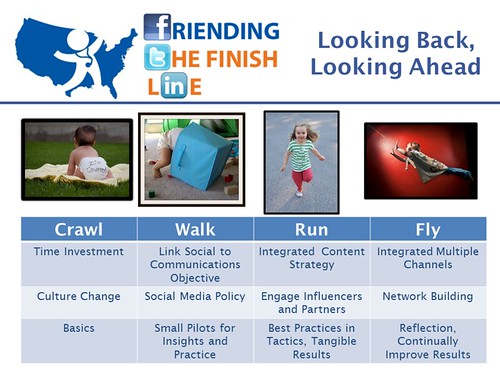
The framework is a social media maturity of practice model called “Crawl, Walk, Run, Fly” Maturity of Social Media and is featured in my next book, Measuring the Networked Nonprofit. We used to help us design the program, determine process outcomes, and help us evaluate participant’s progress. For each phase, there are specific criteria and indicators that an organization will develop. We are tracking progress against a baseline.
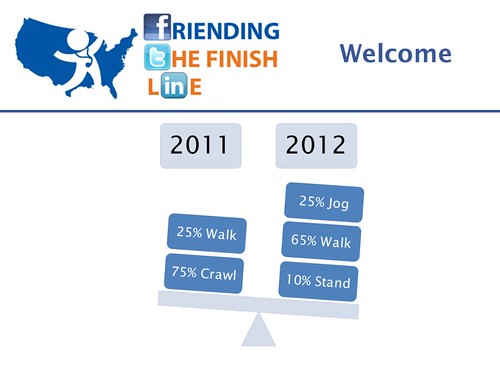
When we started the project, most were in the crawling stage, so there was no place to go but up! When did its first face-to-face convening, participants had just started to communicate with key audiences — we looked at the aggregate Twitter followers and Facebook fans at the beginning and at the end of the second year – and there has been dramatic increases. This comes from participants integrating social media with advocacy and communications strategy and to learn from each other along the way. One of the successes was how most participants are learning to balance the strategic with the spontaneous of social media as described in this blog post.
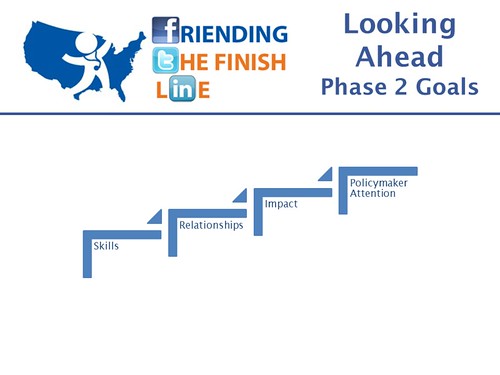
Over the past year, participants have been getting comfortable with social media skills, being strategic, making them a habit, and first steps with measurements. But these are steps to bigger outcomes for this network – such as making sure there is health care for all children. Having a theory of change that illustrates the steps towards these bigger outcomes is critical as well as indicators.
Advocates get better at communications – proactive/planning, partner engagement, message discipline
Written social media policy
Strategic integration into children’s health advocacy
Written social media plan
Use of editorial calendar
Use of counting metrics
Advocates have more partners or better partners, more or better relationships with reporters, and more or better policymaker relationships
Increase reach on social media channels
Cultivate “super fans”
Increase engagement on social channels
Support national partner Facebook chats, blog carnivals, and other networked advocacy activities
Amplify peers’ efforts
Communications have more impact
Social media content mirrors other channels
Solicit and share stories
Key influencers take action, including media
Advocates get more attention from policymakers
Lawmakers repurpose key messages
Training Design

This peer learning exchange has monthly conference calls that balance expert content delivery with peer sharing and making a commitment to put ideas and recommendations into practice over the month. It also includes a face-to-face workshop where there is also the same balance. This year’s session was piggy-backed with the annual meeting, so the training came at the end of 2.5 intense days of meetings. The design incorporate many interactive learning techniques to ensure that participants were actively learning and sharing, and not falling asleep!
It takes time to develop a solid organizational practice in social media, so we wanted to celebrate those small victories. We created a deck of cards with mini-case studies showing examples of how these state advocates had strategically incorporate social media into their social media plan. For example, the All Kids Covered has been using the timeline features to create milestones for legislative victories. We distributed the cards and had participants pair up with peers to learn more about their successes. This type of active exercise gets people moving, serves as an icebreaker, and also is an efficient way for the group to share a lot of useful practical learnings.

The skill building sessions focused on content optimization for integrated social media channels and working SMARTer with social media – time saving tips. For the integrated content strategy, we begin with some principles for an effective content strategy – techniques for coordination, creation, and curation. The ideas were interspersed with examples from participants who shared “Living Case Studies.” This generated useful tips and suggestions on how to manage an editorial calendar and content strategy process. How do you facilitate others on staff to create content when they might not be have strong content skills? What tools do you use to manage the your editorial calendar and content creation process?
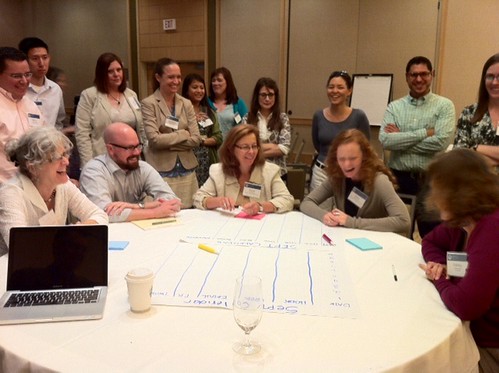
We did a “Fish Bowl” exercise where several volunteers brainstormed an editorial calendar for the month of September, while the rest of the group observed. If one of the observers wanted to participate, they could tap a “fish” on the shoulder and sit down. This is a good exercise because participants are applying some of the ideas and also come to the realization that sharing each other’s editorial calendars can make their work easier. I facilitated the group with specific prompts for social content optimization. This will was followed by a presentation to share those tips drawn from recent research reports:
Ten Types of Content We All Love
http://www.famousbloggers.net/content-types.html
Buddy Media: Twitter Optimization
http://www.buddymedia.com/newsroom/2012/06/buddy-media-twitter-tweeting-best-practices/
How To Get More Likes and Shares on Facebook – Based on Research
http://mashable.com/2012/06/19/how-to-get-more-likes-shares-on-facebook-infographic/
Tips for Optimizing FB Content To Get Into Newsfeeds
http://blog.getpostrocket.com/2012/06/7-easy-ways-to-increase-your-pages-edgerank/
Making Use of the Timeline Features
http://www.socialmediaexaminer.com/facebook-timeline-marketing/
This session closed with a reflection of how they could apply tips and recommendations and use measurement to further test these ideas.
The other skill building session was a session on working SMARTer on social channels – What are the time saving techniques? But, more importantly how could they save time working as network. I set this up as a series of online exercises focusing techniques like setting up Twitter lists, curating content from other Facebook pages, etc. Making the work flow part of the workshop is always a good idea, especially set up tasks.
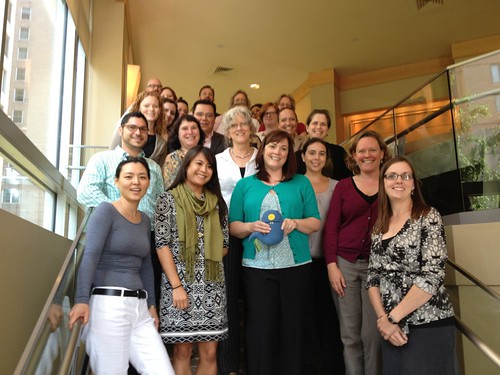
The last section of the workshop was focused on having participants start thinking about their work plan for the coming year. Each participants comes up with specific work plan of what they will accomplish based on the overall outcomes for the program. This second year will be focused on getting participants up on the next level, with an emphasis on building the network and amplifying each other’s work through social channels.
Developing a solid and effective practice in social media and building a network, that is integrated, strategic, and part of the organization’s DNA – takes step and intention. Having a measurement framework, theory of change, and good instructional design to encourage peer sharing and interaction is key.
Beth Kanter is a consultant, author, influencer. virtual trainer & nonprofit innovator in digital transformation & workplace wellbeing.

Leave a Reply